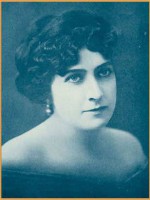Ann Pennington is a Actor American born on 20 december 1893 at New York City (USA)

Ann Pennington (December 23, 1893 – November 4, 1971) was an actress, dancer, and singer who starred on Broadway in the 1910s and 1920s, notably in the Ziegfeld Follies and George White's Scandals.
She became famous for what was, at the time, called a "Shake and Quiver Dancer," and was noted for her variation of the "Black Bottom". She was also noted as an accomplished tap dancer. Ray Henderson wrote the extant version of "Black Bottom" for Ann - she had already been performing the popular version of the dance for some time. Some years prior to this, she had also topped the bill on Broadway in her performance of the musically similar "Charleston".
Pennington also achieved fame as a star of both silent and sound motion pictures.
She began her career on Broadway as a member of the chorus in The Red Widow (1911) starring Raymond Hitchcock. Her debut in the Ziegfeld Follies was in 1913, where she quickly established herself as one Ziegfeld's top attractions.
With dimpled knees and long dark red hair, the petite, pretty, charming, and often scantly-clad Pennington stood a mere 4' 10" tall and wore only a size 1½ shoe. Because of her diminutive stature, she was referred to as "Penny" by her friends and colleagues. Her nickname for herself was "Tiny".
During her years in the Ziegfeld Follies she appeared alongside the likes of Bert Williams, Eddie Cantor, Will Rogers, Fanny Brice (who became her closest friend), Marilyn Miller, and W. C. Fields. She switched back and forth between George White's Scandals and the Follies more than once, earning a salary of $1000 per week well before the 1920s, and continued to moonlight in the early New York film industry. She also frequented Harlem in its jazz heyday.
In the 1926 edition of George White's Scandals, Pennington introduced the African American-influenced Black Bottom dance to America at large with her partner, the eccentric dancer Tom Patricola. First popularized in New York by the African American show Dinaah that had been staged in Harlem in 1924, after Pennington performed the Black Bottom on Broadway, the dance became was a national phenomenon, overtaking The Charleston in popularity.
George Gershwin was her rehearsal pianist and wrote several songs for her. Cole Porter, Ray Henderson, Joe Burke, Oscar Levant and Edward Ward all wrote for her shows, The New Yorkers (1931) being her last great show for Porter. She could sing as well as dance, as evinced by her recording of "Believe Me" (1930).
No films of her signature dance routines have been preserved, with the possible exception of the "Snake-Hips" number which occurs in Happy Days (1929). Her key dances in Gold Diggers on Broadway (1929) remain lost. Some of her scenes from Tanned Legs still survive, but her role in The Great Ziegfeld, while still listed in some inventories, was in fact cut before release. She was also listed as a star in the 1929 Warner Brothers showcase movie "Show of Shows" but her routines were never filmed, perhaps because her main song and dance number "Believe Me" was commandeered by one of Warners' rising stars Irene Bordoni. Ann did however get to perform "Believe Me" in the 1930 movie "Hello Baby!", which is still in print, and sang and danced "You're responsible" in "Tanned Legs" (for which movie she features in uncredited cartoon form on the posters and sheet music).
The New York Times (November 5, 1971) noted:
She liked practical jokes. Once, when a man she didn't particularly like, telephoned, asking, "Is this Miss Pennington?" she replied, "This ain't me." Her dressing room door bore a sign, "For Men Only."
She was until the late 1920s chaperoned at performances by her mother. She was noted for a quick and witty personality, but was said to be shy off stage and easily embarrassed, and in her latter years was loath to discuss her early life.
Pennington was romantically linked to several men during her lifetime, and at one time or another was allegedly engaged to boxer Jack Dempsey, theatrical producer and early dance partner George White, actor Buster West, and musician Brooke Johns. None of these romances lasted and Pennington never married. She never spoke on record about any of her engagements, whether to confirm or deny them.
Ann Pennington never settled in one place for very long. She lived mostly in hotels in New York apart from some years in California as the constant companion of Fanny Brice, whom she had helped out at least once with loans and gifts of jewellery. Ann was noted for her generosity and many of her loans were never repaid; however most of her huge earnings were wiped out over the years by betting at the racetrack, decades of hotel bills, and gifts to charities and churches.
After her years on stage and screen ended, Pennington toured in vaudeville. She retired from performing in the 1940s. She last appeared on stage in a benefit show for the armed forces in 1946. She had a committed work ethic, and worked wherever the opportunity arose, although as she aged and tastes changed, she ended her stage days in shabby theaters with low ranked dance companies. Home movie footage of her "Snake Hips" dance at the 1939 World's Fair survive, but is more memorable for her enthusiasm than her star quality in her fading years.
Ann Pennington died of a stroke in New York City on November 4, 1971, aged 77. She had lived alone on welfare for many years in New York hotels overlooking 42nd Street. She was badly affected by arthritis. She was sometimes recognised shuffling along Broadway as a faded superstar of a world long past- but she was also mugged in her old age on her daily walk to a diner. She is buried in the Valhallia Cemetery in New York. No family were known to have attended her funeral, which was paid for by the Actors Benevolent guild.
A few years before her death, she was asked what had been the greatest reward from her years of stardom, and her reply was "in living, honey".
She was portrayed by actress Michelle Nicastro in the "Scandals of 1920" episode of The Young Indiana Jones Chronicles, which dramatizes her role as the star of George White's Scandals of 1920.
Source : Wikidata
Ann Pennington

Nationality USA
Birth 20 december 1893 at New York City (USA)
Death 4 november 1971 (at 77 years) at New York City (USA)
Birth 20 december 1893 at New York City (USA)
Death 4 november 1971 (at 77 years) at New York City (USA)
She became famous for what was, at the time, called a "Shake and Quiver Dancer," and was noted for her variation of the "Black Bottom". She was also noted as an accomplished tap dancer. Ray Henderson wrote the extant version of "Black Bottom" for Ann - she had already been performing the popular version of the dance for some time. Some years prior to this, she had also topped the bill on Broadway in her performance of the musically similar "Charleston".
Pennington also achieved fame as a star of both silent and sound motion pictures.
Biography
Pennington was born in Wilmington, Delaware on December 23, 1893 and reputedly moved with her family to Camden, New Jersey around 1900. Her father worked for the Victor music company, they were Quakers, and she had at least one sibling, Nellie.She learned to dance with the Professor Wroe dance school, and her first performances in New York were as part of "Wroe's Buds". She wanted to be a classical actress, but her diminutive stature and talent as a dancer conspired against this ambition.She began her career on Broadway as a member of the chorus in The Red Widow (1911) starring Raymond Hitchcock. Her debut in the Ziegfeld Follies was in 1913, where she quickly established herself as one Ziegfeld's top attractions.
With dimpled knees and long dark red hair, the petite, pretty, charming, and often scantly-clad Pennington stood a mere 4' 10" tall and wore only a size 1½ shoe. Because of her diminutive stature, she was referred to as "Penny" by her friends and colleagues. Her nickname for herself was "Tiny".
During her years in the Ziegfeld Follies she appeared alongside the likes of Bert Williams, Eddie Cantor, Will Rogers, Fanny Brice (who became her closest friend), Marilyn Miller, and W. C. Fields. She switched back and forth between George White's Scandals and the Follies more than once, earning a salary of $1000 per week well before the 1920s, and continued to moonlight in the early New York film industry. She also frequented Harlem in its jazz heyday.
In the 1926 edition of George White's Scandals, Pennington introduced the African American-influenced Black Bottom dance to America at large with her partner, the eccentric dancer Tom Patricola. First popularized in New York by the African American show Dinaah that had been staged in Harlem in 1924, after Pennington performed the Black Bottom on Broadway, the dance became was a national phenomenon, overtaking The Charleston in popularity.
George Gershwin was her rehearsal pianist and wrote several songs for her. Cole Porter, Ray Henderson, Joe Burke, Oscar Levant and Edward Ward all wrote for her shows, The New Yorkers (1931) being her last great show for Porter. She could sing as well as dance, as evinced by her recording of "Believe Me" (1930).
No films of her signature dance routines have been preserved, with the possible exception of the "Snake-Hips" number which occurs in Happy Days (1929). Her key dances in Gold Diggers on Broadway (1929) remain lost. Some of her scenes from Tanned Legs still survive, but her role in The Great Ziegfeld, while still listed in some inventories, was in fact cut before release. She was also listed as a star in the 1929 Warner Brothers showcase movie "Show of Shows" but her routines were never filmed, perhaps because her main song and dance number "Believe Me" was commandeered by one of Warners' rising stars Irene Bordoni. Ann did however get to perform "Believe Me" in the 1930 movie "Hello Baby!", which is still in print, and sang and danced "You're responsible" in "Tanned Legs" (for which movie she features in uncredited cartoon form on the posters and sheet music).
The New York Times (November 5, 1971) noted:
She liked practical jokes. Once, when a man she didn't particularly like, telephoned, asking, "Is this Miss Pennington?" she replied, "This ain't me." Her dressing room door bore a sign, "For Men Only."
She was until the late 1920s chaperoned at performances by her mother. She was noted for a quick and witty personality, but was said to be shy off stage and easily embarrassed, and in her latter years was loath to discuss her early life.
Pennington was romantically linked to several men during her lifetime, and at one time or another was allegedly engaged to boxer Jack Dempsey, theatrical producer and early dance partner George White, actor Buster West, and musician Brooke Johns. None of these romances lasted and Pennington never married. She never spoke on record about any of her engagements, whether to confirm or deny them.
Ann Pennington never settled in one place for very long. She lived mostly in hotels in New York apart from some years in California as the constant companion of Fanny Brice, whom she had helped out at least once with loans and gifts of jewellery. Ann was noted for her generosity and many of her loans were never repaid; however most of her huge earnings were wiped out over the years by betting at the racetrack, decades of hotel bills, and gifts to charities and churches.
After her years on stage and screen ended, Pennington toured in vaudeville. She retired from performing in the 1940s. She last appeared on stage in a benefit show for the armed forces in 1946. She had a committed work ethic, and worked wherever the opportunity arose, although as she aged and tastes changed, she ended her stage days in shabby theaters with low ranked dance companies. Home movie footage of her "Snake Hips" dance at the 1939 World's Fair survive, but is more memorable for her enthusiasm than her star quality in her fading years.
Ann Pennington died of a stroke in New York City on November 4, 1971, aged 77. She had lived alone on welfare for many years in New York hotels overlooking 42nd Street. She was badly affected by arthritis. She was sometimes recognised shuffling along Broadway as a faded superstar of a world long past- but she was also mugged in her old age on her daily walk to a diner. She is buried in the Valhallia Cemetery in New York. No family were known to have attended her funeral, which was paid for by the Actors Benevolent guild.
A few years before her death, she was asked what had been the greatest reward from her years of stardom, and her reply was "in living, honey".
She was portrayed by actress Michelle Nicastro in the "Scandals of 1920" episode of The Young Indiana Jones Chronicles, which dramatizes her role as the star of George White's Scandals of 1920.
Usually with
Filmography of Ann Pennington (15 films)
Actress

China Girl (1942)
, 1h35Directed by Henry Hathaway
Origin USA
Genres Drama, War, Romance
Themes Seafaring films, Transport films, Political films, Children's films
Actors Gene Tierney, George Montgomery, Sig Ruman, Lynn Bari, Myron McCormick, Robert Blake
Roles Entertainer
Rating61%





The year is 1941, and in Luichow, China, a news cameraman named Johnny Williams (George Montgomery) is taken into custody by the Japanese military, because they want him to take pictures for them of the Burma Road construction. Johnny will get $20,000 for his work, but he isn't interested.

Gold Diggers of Broadway (1929)
, 1h41Directed by Roy Del Ruth
Origin USA
Genres Comedy, Musical theatre, Musical
Themes Films about music and musicians, Musical films, Films based on plays, Films based on musicals
Actors Winnie Lightner, Nick Lucas, Nancy Welford, Conway Tearle, Ann Pennington, Gertrude Short
Roles Ann Collins
Rating70%





The film opens on an audience watching a lavish 1929 Broadway show, featuring a giant gold mine production number ("Song of the Gold Diggers"). Famous guitarist Nick Lucas sings "Painting the Clouds with Sunshine", which climaxes on stage with a huge art deco revolving sun.

Happy Days (1929)
, 1h20Directed by Benjamin Stoloff
Origin USA
Genres Musical
Themes Films about music and musicians, Musical films
Actors Marjorie White, Stuart Erwin, Charles Farrell, Frank Albertson, George MacFarlane, Janet Gaynor
Roles Dancer - 'Snake Hips' Number
Rating57%





Originally titled New Orleans Frolic, the story centers around Margie (played by Marjorie White), a singer on a showboat who goes to make her fortune in New York City, despite being in love with the boat owner's grandson. Although successful in the city, when she hears that the showboat is in financial trouble she calls all the boat's former stars to perform in a show to rescue it.

Is Everybody Happy? (1929)
, 1h20Directed by Archie Mayo
Origin USA
Genres Drama, Comedy, Musical
Actors Alice Day, Ann Pennington, Lawrence Grant, Julia Swayne Gordon, Otto Hoffman, Purnell Pratt
Roles Lena Schmitt
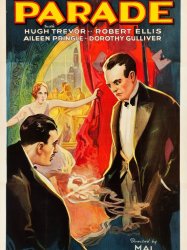
Night Parade (1929)
, 1h11Directed by Malcolm St. Clair
Genres Drama
Themes Sports films, Martial arts films, Boxing films, Films based on plays
Actors Aileen Pringle, Robert Ellis, Hugh Trevor, Dorothy Gulliver, Ann Pennington, Lloyd Ingraham
Roles Ann Pennington
Rating56%





Bobby Murray is the middleweight champion, managed by his father, Tom. He is expected to lose an upcoming fight in defense of his title. A local sportswriter, Sid Durham, also thinks he will lose, but he has high regard for Tom. A gangster, John Zelli, also feels that Murray will lose, but wants to ensure that fact. Zelli enlists the talents of sultry Paula Vernoff to seduce Bobby, and get him to agree to throw the fight.

Tanned Legs (1929)
, 1h11Directed by Marshall Neilan
Genres Comedy
Themes Musical films
Actors Ann Pennington, Arthur Lake, June Clyde, Dorothy Revier, Sally Blane, Albert Gran
Roles Tootie
Rating54%





Peggy is the daughter of Mr. Reynolds and his wife Sophie. Although married, both of the elder Reynolds are having romantic interludes with younger people, Mrs. Lyons-King and Roger Fleming, respectively. In addition, Peggy's sister, Janet, is infatuated with Clinton Darrow, a ne'er-do-well, who is only interested in the Reynolds' money, not in Janet. Peggy is in the only normal relationship, with her boyfriend, Bill.
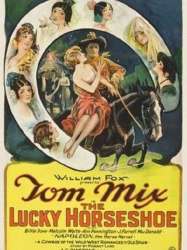
The Lucky Horseshoe (1925)
Directed by John G. Blystone
Origin USA
Genres Western
Actors Tom Mix, Billie Dove, Malcolm Waite, J. Farrell MacDonald, Ann Pennington, Gary Cooper
Roles Dancer
Rating56%





Following the death of the owner of the Hunt ranch, foreman Tom Foster (Tom Mix) assumes responsibility for the property, taking also into his care Eleanor Hunt (Billie Dove), the beautiful daughter of the late owner. Although he falls in love with the girl, Tom is too diffident to express his feelings and propose marriage. Soon after, Eleanor is asked to accompany her aunt to Europe.
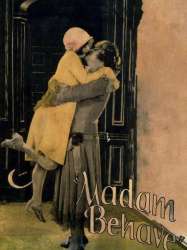
Madame Behave (1925)
Directed by Scott Sidney
Origin USA
Themes Films based on plays
Actors Julian Eltinge, Ann Pennington, Lionel Belmore, Tom Wilson, Jack Duffy, Evelyn Francisco
Roles Gwen Townley
Rating64%





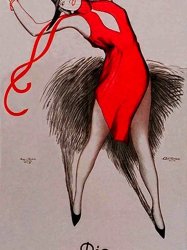
Pretty Ladies (1925)
, 1h14Directed by Monta Bell, Harold S. Bucquet
Origin USA
Genres Drama, Comedy, Comedy-drama
Actors Zasu Pitts, Conrad Nagel, Tom Moore, Joan Crawford, Ann Pennington, Lilyan Tashman
Roles Herself
Rating51%





Maggie (ZaSu Pitts) is a popular Ziegfeld Follies dancing comedienne whose husband leaves her for one of the show's beauties, and who longs for the life of other chorus girls but eventually finds love by being herself.
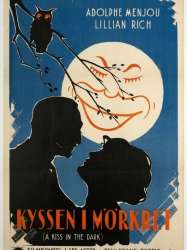
A Kiss in the Dark (1925)
, 1hDirected by Frank Tuttle
Origin USA
Genres Comedy
Actors Adolphe Menjou, Aileen Pringle, Zeppo Marx, Lillian Rich, Kenneth MacKenna, Ann Pennington
Roles Specialty Dancer
Rating67%





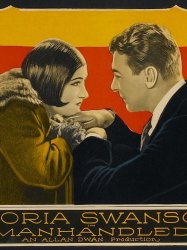
Manhandled (1924)
, 1h15Directed by Allan Dwan
Origin USA
Genres Drama, Comedy, Comedy-drama, Romance
Actors Gloria Swanson, Tom Moore, Lilyan Tashman, Ian Keith, Arthur Housman, Paul McAllister
Roles Herself
Rating66%





Lorsque son petit ami, Jimmy, oublie l'un de leurs rendez-vous, Tessie McGuire se rend à une fête chez Robert Brandt. Elle y fera forte impression.

Sunshine Nan (1918)
, 50minutesDirected by Charles Giblyn
Origin USA
Genres Comedy-drama
Actors Ann Pennington, Richard Barthelmess, Frank Losee, Johnny Hines, Charles Eldridge
Roles Nance Molloy
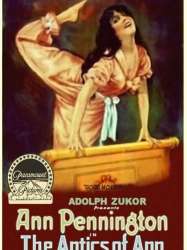
The Antics of Ann (1917)
Directed by Edward Dillon
Origin USA
Genres Comedy
Actors Ann Pennington, Crauford Kent
Roles Ann Wharton
As described in a film magazine, after breaking every rule in the Bredwell Seminary, Ann Wharton (Pennington) is dismissed. Seeking to beat the notification of her dismissal to her father, she runs away from school that night. She goes to sleep in a row boat and is awakened the next morning when her craft bumps a railroad bridge. After meeting Tom Randall (Ham), with whom she has formed a friendship, he takes her home where her father (Carleton) finds them, having been appraised by the seminary principal who hinted at an elopement. Ann is then taken to a winter resort where her father and sister Olive (Hawley) are staying. Here Tom finds her again. She breaks up an elopement of her sister and a fortune hunter by going to the latter's room and staying there until the time for the tryst has passed. Accused of compromising herself by her father, she goes to Tom's apartment and demands that he marry her, which he does. The couple receive the blessing of her father.

The Little Boy Scout (1917)
Directed by Francis J. Grandon
Origin USA
Actors Ann Pennington
Roles Justina Howland
As described in a film magazine review, the film takes place during the American troop maneuvers along the border during the Mexican Revolution. Justina Howland (Pennington) lives with Miguel Alvarez (Fraunholtz), her Mexican guardian, who insists that she marry his son Luis (Burton). On the eve of the wedding Justina rebels and leaves, and at the border is taken in by Thomas Morton (Moore) and his company of Massachusetts soldiers. Justina goes to live with her aunt Elizabeth (Harris) and, shortly after her arrival there, the troops from the border return and Justina renews her acquaintance with Thomas. In order to save herself from her Mexican uncle, who has pursued her, she marries Thomas.

Susie Snowflake (1916)
, 50minutesDirected by James Kirkwood Sr.
Origin USA
Genres Comedy
Actors Ann Pennington, William Courtleigh, Jr., Leo Delaney, William J. Butler, Marcia Harris
Roles Susie
 Connection
Connection




